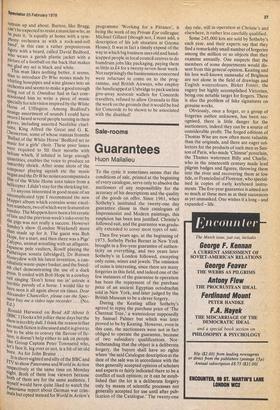Sale-rooms
Guarantees
Huon Mallalieu
To the cynic it sometimes seems that the conditions of sale, printed at the beginning of every catalogue, serve only to absolve the auctioneer of any responsibility for the accuracy of his descriptions and the quality of the goods on offer. Since 1961, when Sotheby's instituted the twenty-one day guarantee clause in their catalogues of Impressionist and Modern paintings, this suspicion has been less justified. Christie's followed suit, and the guarantee was gradually extended to cover most types of sale.
Then five years ago, at the beginning of 1973, Sotheby Parke Bernet in New York brought in a five-year guarantee of authenticity on everything, and two years later Sotheby's in London followed, excepting only coins, wines and jewels. The omission of coins is interesting, since there are many forgeries in this field, and indeed one of the few instances of the guarantee in operation has been the repayment of the purchase price of an ancient Egyptian octodrachm sold in New York, and later judged by the British Museum to be a clever forgery.
During the Keating affair Sotheby's agreed to repay the purchase price of 'The Chestnut Tree,' a watercolour supposedly by Samuel Palmer but which was later proved to be by Keating. However, even in this case, the auctioneers were not in fact obliged to operate the guarantee, because of two subsidiary qualifications. Notwithstanding that the object is a deliberate forgery, the buyers shall have no rights where 'the said Catalogue description at the date of the sale was in accordance with the then generally accepted opinion of scholars and experts or fairly indicated there to be a conflict of such opinion; or it can be established that the lot is a deliberate forgery only by means of scientific processes not generally accepted for use until after publication of the Catalogue.' The twenty-one
day rule, still in operation at Christie's and elsewhere, is rather less carefully qualified. Some 245,000 lots are sold by Sotheby's each year, and their experts say that they find a remarkably small number of forgeries among the million or so objects that they examine annually. One suspects that the members of some departments would dissent from this general opinion. Keating and his less well-known namesake of Brighton are not alone in the field of drawings and English watercolours, Birket Foster, the sugary but highly accomplished Victorian, being one notable target for forgers. There is also the problem of fake signatures on genuine works.
Obviously, once a forger, or a group of forgeries author unknown, has been recognised, there is little danger for the auctioneers, indeed they can be a source of considerable profit. The forged editions of Thomas Wise are now often more valuable than the originals, and there are eager collectors for the products of such men as Sanson of Paris, who made 'Chinese' porcelain, the Thames watermen Billy and Charlie, who in the nineteenth century made lead pilgrim badges and figures, throwing them into the river and recovering them at low tide, or Franciolini of Florence, who specialised in copies of early keyboard instruments. The five-year guarantee is aimed not so much at these men as at their successors as yet unmasked. One wishes it a long — and expanded — life.


































 Previous page
Previous page